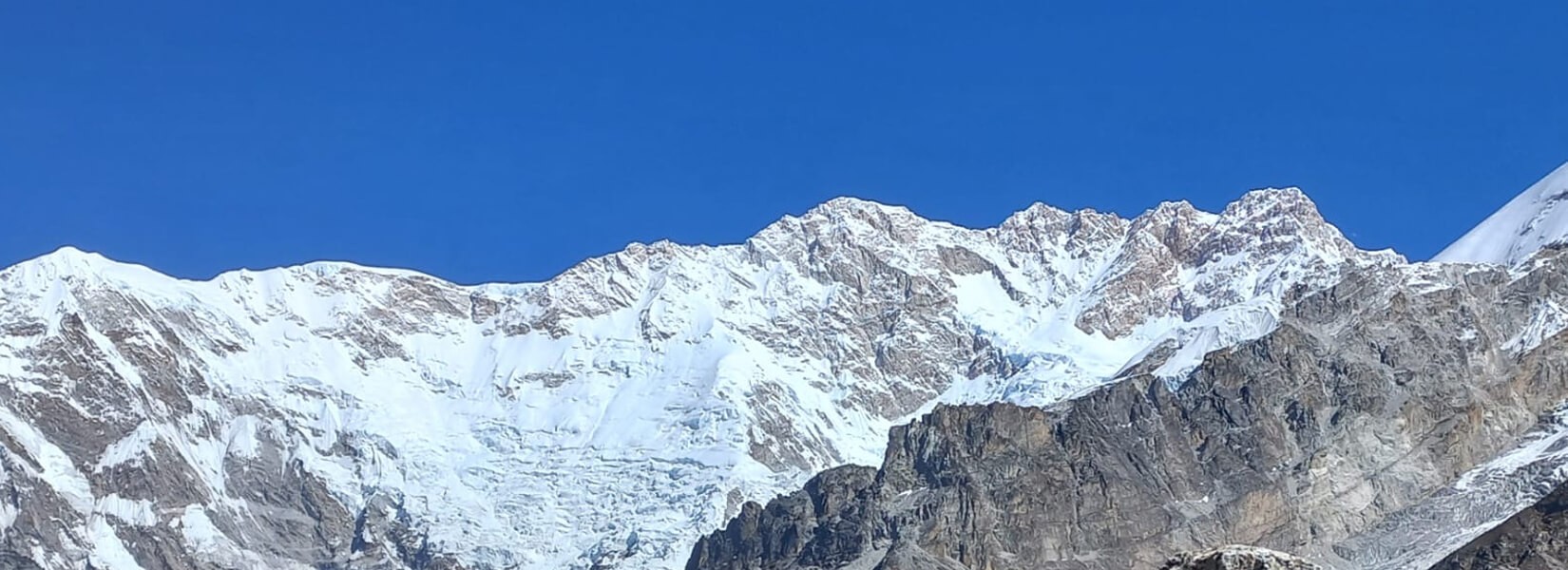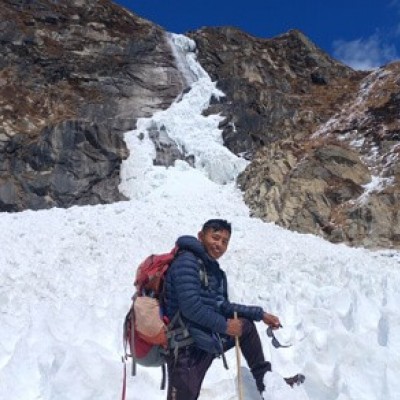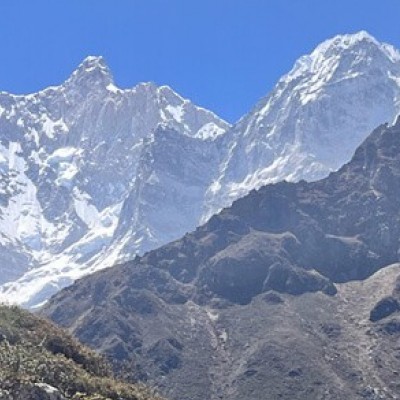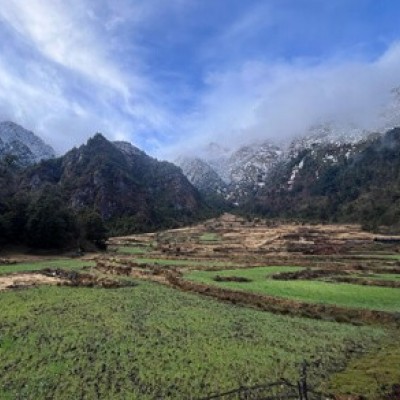What are the key points of the Kanchenjunga Trekking?
Pristine trails in the Kanchenjunga region present you with awe-inspiring scenery, featuring panoramas of majestic peaks, including Mt. Kanchenjunga (8586m), the third-highest mountain on Earth. Following in the footsteps of several legendary expeditionists, encounter unique Himalayan cultures and traditions in Nepal’s most remote areas. Hiking takes you from lush forests to high-elevation, less-traversed settlements, rich in ecosystem diversity, allowing you to combine cultural heritages influenced by Tibetan Buddhism with the surreal charm of nature. The highlights of the Kanchenjunga trek are as follows:
How do snow-clad mountains captivate you?
Breathtaking vistas of dramatic mountain giants, including the best views of Kanchenjunga, will provide relief while hiking on the Kanchenjunga trail, far from the chaos of bustling cities. Savor the beauty of neighboring peaks such as Makalu, Lhotse, Kabru, Jannu, etc., from famous vantage points like Kanchenjunga South/Oktang Base Camp (4730m) and Kanchenjunga North/Pangpema Base Camp (5143m).
The best seasons for witnessing wonderful scenery with peak views without obstructions are autumn and spring. Therefore, choose these optimal periods to avoid winter Kanchenjunga trekking challenges and possible unforeseen events of the Monsoon Kanchenjunga Trekking.
What specific flora and fauna can you expect to see during the Kanchenjunga trek?
Kanchenjunga trekking is more than an ordinary hiking as it offers you to see diverse Himalayan species while trekking through the Kanchenjunga Conservation Area, since it has a wide range of flora and fauna. Nature lovers and photography enthusiasts can capture the activities of endangered animals, including Himalayan Tahr, snow leopards, red pandas, Indian leopards, Himalayan black bears, langur monkeys, etc., in their natural habitat. On the other hand, walk along the forests of bamboo, firs, magnolias, and rhododendrons by listening to tree rustlings and bird chirpings.
The Kanchenjunga region has over 2000 kinds of vegetation: verdant subtropical forests at lower elevations and alpine meadows, including herbs, at high-altitude mountainous landscapes and rugged terrains. The region is also home to more than two hundred and fifty species of birds, offering birdwatchers and photographers a perfect place to enjoy them. The main types of birds are blood pheasant, Himalayan monal, Himalayan griffon, etc.
How Does the Kanchenjunga Trek Connect You to Local Heritage?
Unlike more commercialized trekking paths like Everest Base Camp or Annapurna Base Camp, the Kanchenjunga trekking route provides you with more space to explore the unique cultures of Sherpa, Rai, and Limbu, taking you to remote settlements of different ethnic groups like Sekathum, Amjilosa, Gyabla, Ghunsa, Khambachen, Lhonak, Cheram, Ramche, etc. Embrace locals’ warm hospitality and taste a variety of Himalayan dishes at teahouses.
Different ancient monasteries and gompas adorned with prayer wheels, prayer flags, and mani walls will allow you to gain deep knowledge about Tibetan Buddhism. In addition, witness the activities of monks and nuns, including morning prayer and morning chanting.
What factors contribute to the difficulty of the Kanchenjunga Trek?
The trek is rewarding and demanding while navigating diverse landmarks, including steep ascents and alpine passes such as Mirgin La Pass (4480 m) and Sele La Pass (4290 m). Trekking to the south and north base camps of the Kanchenjunga through rugged terrains and glacial valleys requires good physical fitness. At high elevations above 5000m, the low level of oxygen increases the risk of high-altitude-related problems. If you select off-seasons like winter and monsoon, then rainfalls, snowstorms, and avalanches make the journey more difficult.
Hence, the factors that contribute to the difficulty level of the Kanchenjunga trek include debris-covered slopes, changing weather, high mountain passes, and the duration and length of the Kanchenjunga trek. Therefore, choosing the best time for Kanchenjunga, wise packing lists, and enough acclimatization period are essential.
Why is timing important for trekking in the Kanchenjunga region?
Hiking at the heart of the Kanchenjunga region, situated in far-eastern Nepal near the border between Nepal and India, is generally considered a moderate to strenuous journey. Selecting an optimal period assists you in accomplishing the Kanchenjunga trek, considering its difficulty level and various factors. Even though each season of the year brings unique characteristics, both rewards and limitations, off-seasons (winter and monsoon) might create more obstacles on trails, affecting the entire experience. Physically and mentally sound adventurers also know the variations in climate and altitude and should be cautious before a prompt change in weather.
Encounter the best views of Kanchenjunga during trekking months like autumn and spring, when the weather in the Kanchenjunga region becomes pleasant and temperatures are moderate, allowing you to see breathtaking scenes with clear skies. During these periods, trekkers find it easier to traverse high passes like Sele La, Mirgin La, other landslide-prone areas, and steep ascending trails since the trails are dry and safer. However, monsoon’s heavy rains cause slick paths and landslides, whereas winter does not let you trek with joy due to severe cold and icy trails. The right period ensures every adventurer’s safety and a more enjoyable once-in-a-lifetime journey.
When is the Best time for Kanchenjunga trekking?
As mentioned above, spring (March to May) and autumn (September to November) are the best seasons for Kanchenjunga trekking due to stable weather and moderate temperatures in those months. The trail conditions become safer as there will be less possibility of rain and snowfall, making the temperature more enjoyable with the clearest mountain vistas of Mt. Kanchenjunga (8586m) and its surrounding peaks. Selecting the optimal period is crucial for incredible memories to last, since the unpredictable Kanchenjunga Climate Conditions, high elevation, and isolated settlements present challenges on the way.
Spring Season: The perfect time for Kanchenjunga Trekking
The spring season brings the next level of glow to nature, ranging from March to May, making it one of the best seasons for Kanchenjunga trekking. Rhododendrons and other wildflowers decorate the trails with their vibrant colors and fragrances, enhancing the natural environment. While trekking through some sections of the Kanchenjunga Conservation Area, the suitable weather during this time allows you to enjoy watching the captivating activities of rare animals.
Don’t miss taking pleasure in serene, lush forests with the sound of birds chirping, trees rustling, rivers roaring, and waterfalls cascading. From high Himalayan passes like Mirgin La and Sele La, capture the magnificent pictures of sunrises over the Himalayan ranges, whether you are a novice or professional photographer. Since the weather in the Kanchenjunga region remains stable with moderate temperatures, adventurers can have fun to the fullest without numerous challenges in a comfortable way.
Light rainfall reduces the risk of avalanches or landslides, making your Himalayan journey more exciting. During the snow, some great festivals like the Full Moon of Buddha (Buddha Purnima) take place, offering you the chance to indulge in local cultures and traditions influenced by Tibetan Buddhism. While involving yourself in festive endurance, you can make a deep connection to the locals and also witness their cultural and agricultural activities and the unique architecture of the Himalayas, adding an extra layer of cultural immersion to your adventure in the heart of far-eastern Nepal.
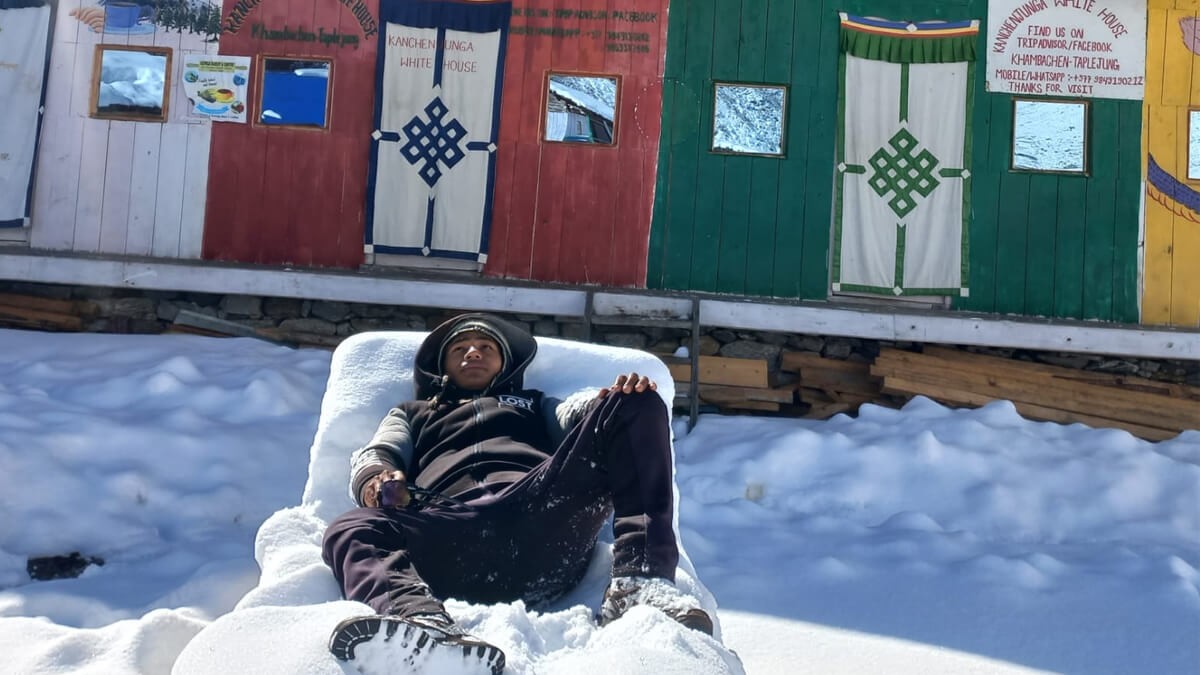
Autumn (September to November): Ideal Weather and Clear Views for Kanchenjunga Trekking
The post-monsoon months (autumn season) call adventurers to the diverse landscapes of the Himalayas in Nepal, including the Kanchenjunga region. The dry trails allow you to savor the beauty of majestic peaks without any blockages as the sky becomes crystal clear after the monsoon rains. Lush forests glow with golden colors, creating a favorable environment with moderate Kanchenjunga Climate Conditions, and you see the locals working in farmlands happily by celebrating the moment of the harvesting period.
In addition, the key feature of autumn is cultural immersion while celebrating national festivals such as Dashain, Tihar, and Chhath. The different programs organized during the season will add enjoyment while diving into the wilderness of the Kanchenjunga region with moderate temperatures and little likelihood of rainfall.
Numerous trekkers from all over the world love visiting during this golden time of the year because of the suitable period and temperature. Since the trekking trail becomes busier during the Kanchenjunga trekking months, we advise you to commence trekking in late October or early November to avoid large crowds, ensuring teahouse availability. Make a plan to accomplish your trip in Kanchenjunga before the late months of November, when the teahouses and guesthouses might close as the harsh cold of the winter starts.
How Do Monsoon and Winter Seasons Increase the Challenges of Kanchenjunga Trekking?
Nepal has several trekking destinations for adventurers regardless of physical fitness level and age. All the things that matter during the journey are the weather and temperature, which can cause difficulties. Although Nepal trekking is possible all year round, monsoon (June to August) and Winter (December to February) are considered off-seasons for trekking in any trekking routes, including the Kanchenjunga region. The advantages and disadvantages of the Monsoon and winter seasons are as follows:
Monsoon Season: Why Is Monsoon Kanchenjunga Trekking Less Suitable?
The monsoon season brings heavy rain to most places in Nepal, making navigation of the paths strenuous due to slippery and muddy trails. Since the Kanchenjunga region consists of numerous high-altitude remote areas, the difficulties increase when trekkers get injured from falls and slips while walking on steep and narrow paths. In such conditions, you might find the journey physically challenging and logistically tough, requiring a high physical fitness level and sufficient training for steep ascents and technical descents.
While proceeding to the Kanchenjunga Base Camps, you traverse landslide-prone areas that cause the blockage of the trails, obliging trekkers to return or take unsafe routes off the main path. Due to perpetual clouds and fog, hikers cannot enjoy the major attractions, including the awe-inspiring vistas of snow-capped peaks. In addition, the possibility of increasing insects like leeches and mosquitoes irritates adventurers on trails that are exposed due to humid conditions.
The potential chances of unpredictable weather in the Kanchenjunga region during the monsoon will not allow you to continue your journey as per your scheduled itinerary. Heavy rains and other unforeseen events can delay flights and interrupt trekking itineraries, making planning unreliable.
What are the Winter Kanchenjunga Trekking Challenges?
The major reason that makes it difficult to trek to the Kanchenjunga region during the winter season is heavy snowfall and severe cold, since the temperature decreases to -10°C to -25°C in high-elevation mountainous regions. Heavy snowfall and avalanches often force trekkers to get back without completing the journey, as the high passes like Sele Le Pass and Mirgin La Pass are strenuous to cross in such conditions.
Trekkers can not find enough teahouses and guesthouses along the trekking trails, like in the spring and autumn seasons, as local people migrate to lower parts by closing teahouses. The Kanchenjunga region is also one of the longest hiking routes in Nepal, where hikers walk approximately 6 to 7 hours to complete the trip on time, depending on the itinerary. Winter season’s daylight hours are shorter, reducing suitable hiking time and heightening the danger of getting stuck outside after dark in freezing conditions.
The harsh winter cold often raises the risk of frostbite, and cold stress, and altitude sickness occurs due to thinner air in the high-elevation terrain. Even you can not properly adapt to the environment since the snow and chilly wind disrupt the acclimatization period. Even though trekking does not require technical skills like those for the Kanchenjunga Expedition, icy and snowy trails create difficulty in crossing the diverse landscapes, presenting significant safety risks.
To sum up, we usually do not recommend that trekkers embark on the Kanchenjunga trek during the monsoon and winter seasons due to harsh weather, logistical challenges, and potential dangers. However, we can manage some trekking packages for both seasons based on your preferences. During the monsoon, rain-shadow areas such as Upper Mustang, Narphu Valley, and the Upper Dolpo region are suitable.
Likewise, the Mardi Himal Trek, Langtang Valley Trek, Ghorepani Poonhill Trek, Tamang Heritage Trek, and Everest Panorama trek are appropriate for the winter season. Adventurers who are seeking places to play with snow and places for snowboarding and skating, the Gosaikunda Lake Trek is a perfect one.
Conclusion
To conclude, stable weather and moderate temperature make Kanchenjunga trails accessible and offer the best views of Kanchenjunga and neighboring peaks. After reading this blog, the selection between Spring vs autumn trekking in Kanchenjunga generally depends on whether you prefer crystal-clear mountain vistas or trails adorned with blooming rhododendrons. Therefore, choose the right period and reputable trekking agencies for safer and more enjoyable moments in the wilderness of far-eastern Nepal.
Nepal Adventure Team is a trekking company of responsible members, including licensed and trained guides. We take full accountability for guiding hikers' safety throughout the entire journey that takes place in high-altitude, isolated areas with demanding trails. Design your Kanchenjunga trek with Nepal Adventure Team today to discover the pristine, untamed Himalayan landscapes to accomplish the journey without worries.
We have different packages for the Kanchenjunga region, the Everest region, the Annapurna region, etc. It’s your choice for your next trip in the heart of the Himalayas for long-lasting memories. 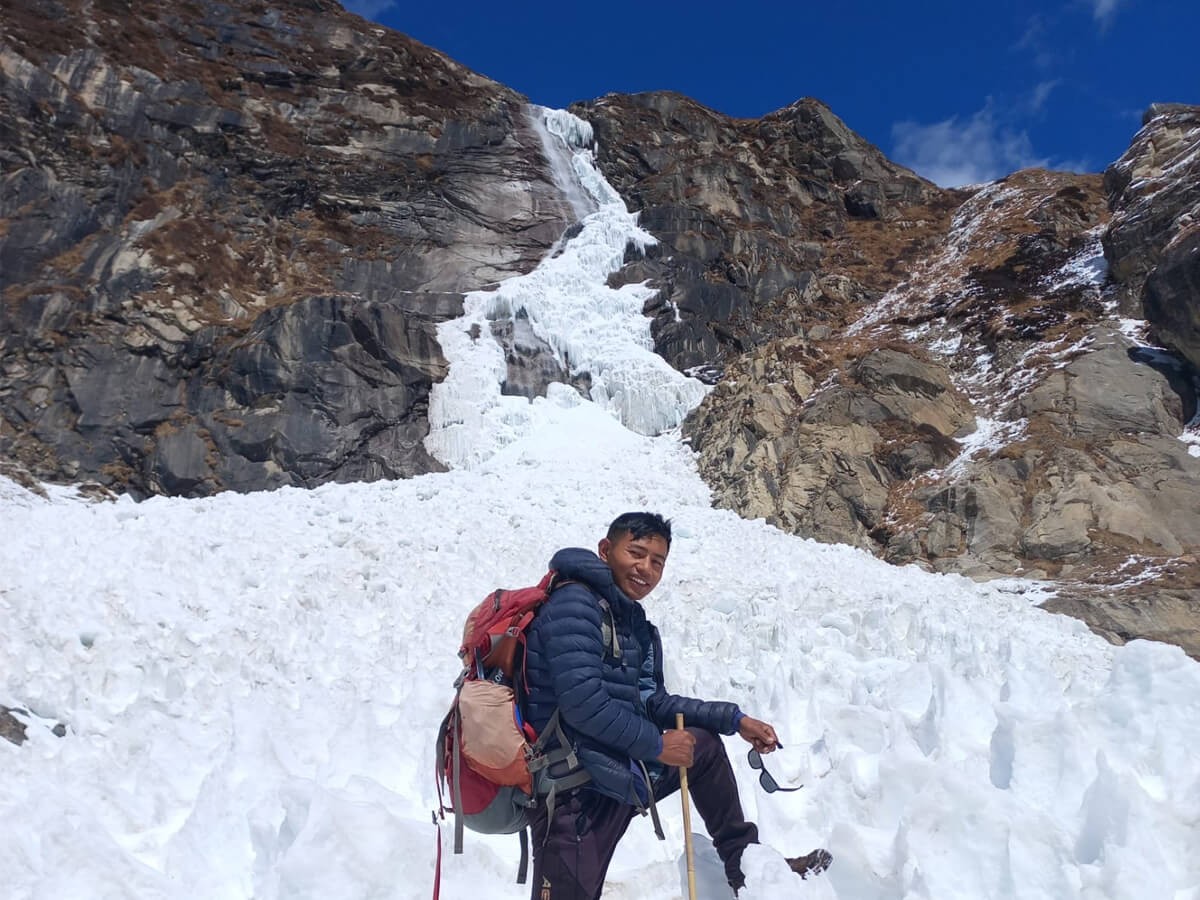
FAQs
What permits do you need to obtain for the Kanchenjunga trekking?
Before embarking on the Kanchenjunga trekking, trekkers need to obtain a TIMS (Trekkers Information Management System) Card, a Kanchenjunga Conservation Area Permit, and a Kanchenjunga Restricted Area Permit. These permits are mandatory as per the Nepal Government’s rule to ensure every trekker’s safety throughout the journey, as well as protecting the fragile ecosystem of preserved areas.
In addition, permits assist in monitoring and controlling the number of visitors to prevent overcrowding. Locals also gain benefits from tourism in the economic aspect. Since an individual can get permits when he/she is accompanied by a licensed guide, it enhances safety and cultural immersion. If you are involved in trekking activities in Nepal without permits, you need to pay penalties. Therefore, do not underscore the essential importance of this compulsion for responsible tourism in Nepal.
Why do you need Travel Insurance for the Kanchenjunga trekking?
What to do if you get injured or suffer from high-altitude-related problems while navigating mountainous terrains. You can get limited health posts and be far from settlements, delaying your treatment, and the expenses for hospitals make your expenses high. Nevertheless, if you have travel insurance, it works as a safeguard and lets you enjoy trekking without worries. While choosing the travel insurance, ensure that it covers helicopter evacuation above 4000m above sea level in case of emergency. Generally, travel insurance covers flight delay or cancellation, personal belongings damage, theft, or cancellation, letting you feel safe and helping in financial protection.
What accommodation and food are available along the Kanchenjunga trails?
You will find basic teahouses in most sections of the Kanchenjunga region, which might be small but comfortable for staying and sleeping. Common teahouses will provide you with shared rooms with twin beds and shared bathrooms. You can carry a light sleeping bag for extra warmth in high-altitude terrain. In settlements of lower elevations, more comfortable teahouses with personal accommodations and contemporary amenities.
As you ascend to the higher areas like Khamabachen and Ghunsa, enjoy the teahouses run by locals. The family-friendly environment of teahouses allows you to immerse yourself in Himalayan cultures and taste different Himalayan cuisines. In isolated sections of the trek, such as Lhonak and Pangpema, accommodations are limited, with minimal options for food.
How long does the Kanchenjunga trek usually take?
The duration of the Kanchenjunga trek generally depends on your physical fitness level, acclimatization needs, the selected itinerary, and your walking pace. Due to the difficult mountainous landscapes of the Kanchenjunga region, it takes quite a long time to complete the journey here. Most trekkers can complete the journey in the Kanchenjunga in between 16 and 25 days. However, the full Kanchenjunga Circuit trek usually concludes within 20 to 25 days, which covers about 200 to 220 kilometers. Trekkers have to walk approximately 5 to 7 hours per day with some ascents and descents. However, some short Kanchenjunga treks can last for 10 to 15 days by flying directly to Suketar.
Do you need a guide and a porter for the Kanchenjunga trekking?
There is no compulsion to hire a porter for your journey, whereas a professional guide is mandatory for obtaining Kanchenjunga trekking permits. The guide ensures your safety throughout the journey, assisting you in navigating difficult sections with the knowledge of predicted weather in the local places of the region. Since the guide has expertise in local dialect, history of places, and cultures, you can have deep insight into authentic cultural heritage. Likewise, a porter allows you to walk on steep and narrow trails without worrying about heavy loads. Hence, we advise hiring both a seasoned guide and a local porter to enhance your entire trekking experience.
